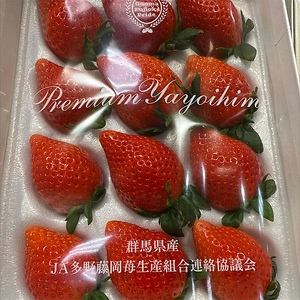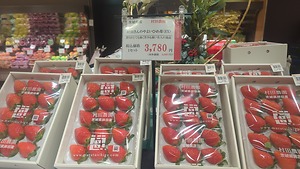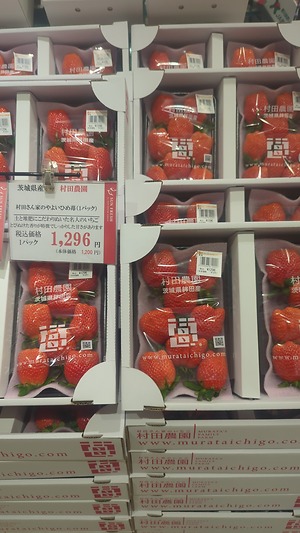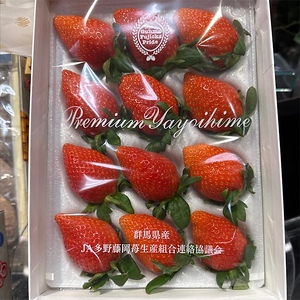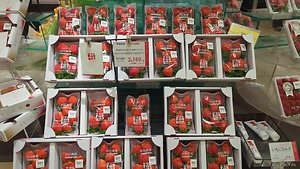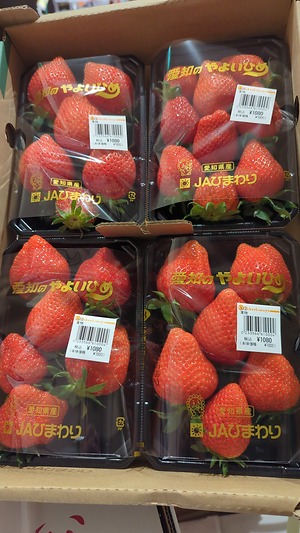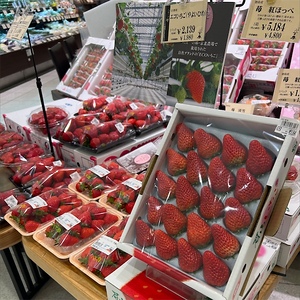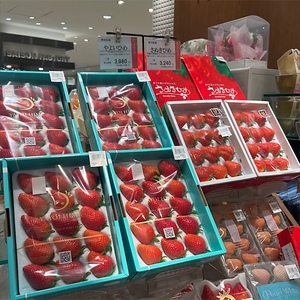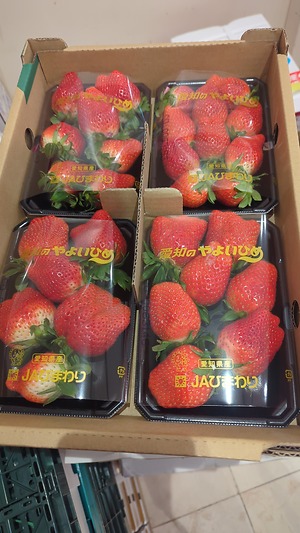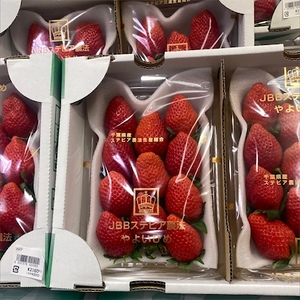


Yayoihime Strawberries
Estimated Inventory, lb : 0
Description/Taste
Yayoihime strawberries are a medium to large varietal, averaging 2 to 5 centimeters in diameter, and have a conical shape, tapering from the slender shoulders down to a pointed tip. The strawberries are capped with long, lanceolate-shaped leaves that drape over the shoulders in a circular formation, and the red to pale red skin is dotted with yellow-green seeds. The skin is also thin and delicate, being easily punctured, bruised, or damaged, and has a smooth, glossy appearance. Underneath the surface, the flesh is semi-firm but soft with a tender, aqueous, and succulent consistency. The flesh is primarily white to pale red with veining and is solid, absent of holes or hollow centers. Yayoihime strawberries emit a sweet, fruity scent when ripe and provide a soft and crisp bite, contrasting the texture of the seeds with the succulent flesh. Yayoihime strawberries have a sweet, fruity, and bright flavor combined with subtly tart and lightly fermented nuances.
Seasons/Availability
Yayoihime strawberries are available in the winter through early summer.
Current Facts
Yayoihime strawberries, botanically classified as Fragaria ananassa, are a rare Japanese variety belonging to the Rosaceae family. The sweet, subtly tangy strawberries were developed in the late 20th century to create an improved cultivar suitable for production in the Gunma region of Japan. Yayoihime strawberries were selected for their productive yields, large size, sweet flavor, and extended season, staying fresh for a longer period compared to other more delicate Japanese strawberries. The variety is mainly grown in the Gunma Prefecture, and when in season, the fruits are sold direct to consumers from local farms to increase agrotourism and business in the Gunma area. This modern strawberry cultivar has attracted the attention of young farmers in Japan as they desire to create a farm that can produce quality fruits and provide a memorable experience for visitors beyond purchasing and eating strawberries. Several of these farms have developed u-pick experiences centered around Yayoihime strawberries and choose only to offer the fruits at the farm, enhancing the cultivar’s exclusivity.
Nutritional Value
Yayoihime strawberries are a good source of vitamin C to strengthen the immune system, boost collagen production, and reduce inflammation within the body. The strawberries also provide vitamin A to maintain healthy organ functioning, vitamin E to protect the cells against the damage caused by free radicals, fiber to regulate the digestive tract, and other nutrients, including potassium, zinc, vitamin K, iron, magnesium, manganese, calcium, copper, and phosphorus.
Applications
Yayoihime strawberries are customarily served fresh, out-of-hand to showcase the fruit’s coloring, soft texture, and sweet, mildly tangy flavor. In Japan, Yayoihime strawberries are traditionally given as gifts for weddings, anniversaries, birthdays, and religious holidays. The fruits are intricately wrapped in ornate boxes to prevent bruising, and depending on the size, quality, and shape of the fruit, the luxury strawberries are served whole on decorative platters or consumed directly from the gift box, which is part of the fruit’s visual presentation. Yayoihime strawberries can also be eaten with condensed milk as a sweet accompaniment, similar to how Americans eat strawberries dipped in chocolate. One unusual way strawberries are eaten fresh in Japan is by consuming the fruits from the stem end to the tip. Japanese strawberry enthusiasts believe that the sweetest part of the strawberry is the tip of the fruit, and they choose to each the fruit in sections, beginning with the flesh surrounding the stem, moving to the center, and finally the tip of the fruit to taste the progression of sweetness. In addition to eating the fruits whole, Yayoihime strawberries can be covered in sweet bean paste and wrapped in a thin layer of mochi as a soft and delicate dessert. They can also be incorporated as a premium topping over shortcakes, crepes, pancakes, tarts, and whipped cream-based desserts or blended into smoothies for a sweet, fruity flavor. Beyond fresh preparations, Yayoihime strawberries can be simmered into jams and jellies and drizzled over desserts or spread on toast. Yayoihime strawberries pair well with chocolate, vanilla, condensed milk, cream, caramel, herbs such as mint, basil, and fennel, and other fruits, including blueberries, raspberries, and peaches. Whole, unwashed Yayoihime strawberries have a short shelf life and should be consumed immediately for the best quality and flavor. The fruits can also be stored in the refrigerator in a plastic bag for 1 to 2 days.
Ethnic/Cultural Info
Yayoihime strawberries earned their name from “Yayoi,” the Japanese word for March. The fruits acquired their monthly moniker from their ability to maintain quality, flavor, and availability through March, a time when strawberries typically suffer due to warmer weather. The cultivar’s hardiness and extended season are the variety’s most famous quality, earning it the title of the representative strawberry of the Gunma Prefecture. Gunma growers also favor Yayoihime strawberries for their productive and fast-growing nature. The Gunma Prefecture produces around 80% of the Yayoihime strawberries available in Japan, but despite its popularity locally in the prefecture, Yayoihime strawberries have remained relatively rare outside of the region as they are primarily sold through local markets throughout Gunma.
Geography/History
Yayoihime strawberries were developed from an initial cross between tonehoppe and tochiotome strawberries, and then the product of that cross was bred with tochiotome for a second time to create the new variety. Yayoihime strawberries were produced through the Gunma Agricultural Technology Center in Gunma Prefecture of Japan. The Gunma Prefecture is located in Central Japan, approximately 60 miles northwest of Tokyo, and is a region known for its long daylight hours, even during the winter. This allows strawberries to receive ample sunlight to promote photosynthesis, making the fruits sweeter. During the creation of Yayoihime strawberries, the Gunma Agricultural Technology Center sought to develop a new cultivar that showcased improved growth characteristics. In the late 20th century and early 21st centuries, the highly productive and fast-growing variety was selected for production and was registered in 2005 as No. 12576. This variety was eventually named Yayoihime, and today the strawberries are primarily localized to the Gunma Prefecture. Yayoihime strawberries are also cultivated on a small scale in a few other prefectures and are offered directly from farms or through select retailers. Beyond domestic sales, Yayoihime strawberries are air-flown to areas of continental Asia. The Yayoihime strawberries featured in the photograph above were sourced from Meidi-Ya Supermarket in the Millenia Walk in Singapore.



